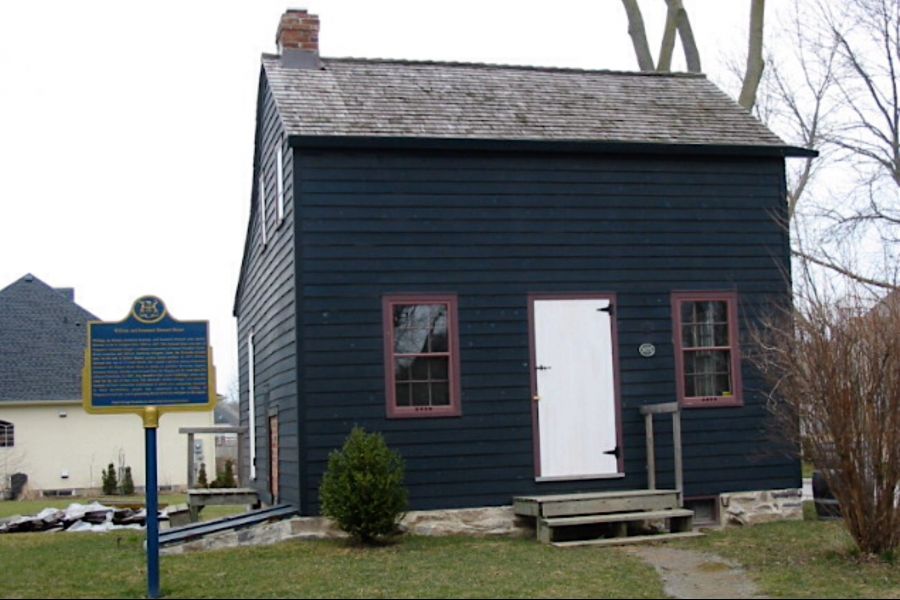CORRECTION: The original photo in this story said it was the court house on Queen Street, however it was the old court house on Rye Street.
Michael Pawlowski
Special to The Lake Report
On Sept. 12, we celebrate the 183rd anniversary of the 1837 Niagara Rebellion. We encourage all residents of Niagara-on-the-Lake and the Niagara Region to contemplate their good fortune and to praise our Afro-Canadian community for its contribution to our history.
Solomon Moseby escaped slavery in Kentucky in May of 1837. His experience with freedom in Niagara Town was brief. Solomon was seized by American bounty hunters who had access to Upper Canada. Lt.- Gov. Francis Bond Head agreed to Moseby’s extradition.
Black and white citizens united in their efforts to free the former slave. While being transferred from the jail to the harbour, Moseby escaped. Two rioters died. Others were arrested. After escaping, Moseby fled the province.
In celebrating the contribution of our Afro-Canadian community to our history we are mindful that they were not just the victim, but also the victors, for the Niagara Rebellion was the only revolt in 1837 that succeeded.
Although Upper Canada had taken steps to abolish slavery in 1793 and the British Empire enacted more encompassing legislation in 1834, Upper Canada still had its Alien Act of 1804 and the Fugitive Offenders Act of 1833.
These two provincial statutes allowed the government to deport any refugee who had committed a capital offence. For the former slaves, this prospect continued to cause some uncertainty. After the Niagara Rebellion, that skepticism in the Black community became fear with the realization that promises of freedom and opportunity were not assurances. After all, Niagara Town was administered only by a sheriff who reported directly to the attorney-general.
The efforts of the plantation owner to regain custody of his slave could truly be called “total racial revenge.” He clearly spent more than the value of a slave to achieve his goal.
John Breckenridge was the owner of the original Kentucky plantation. He was also the attorney-general in Thomas Jefferson’s cabinet. Those who were demanding Solomon Moseby’s extradition were fundamentally the upper echelon of the law in the United States capital and of the militia in western New York.
The temperment of Bond Head is clearly identified in his reply to the former slave’s legal counsel. This was the government’s final decision.
“It is true, that a slave in the United States is not a free agent, and that he becomes so the instant he arrives in Upper Canada; but in obtaining freedom, he becomes also responsible for his conduct, like other free men. British law gives him as much freedom as belongs to British subjects, but no more. This land of liberty cannot be made an asylum for the guilty of any colour.”
“The individual in question has been proved to have been guilty of recent felony. I believe him to have committed it, and I have reason to believe that you are of that opinion. Under these circumstances, I cannot conscientiously, on account of his colour, refuse to deliver him up to the American authorities.”
Clearly, Solomon Moseby’s colour influenced that decision.
Consider the anxieties in the Afro-Canadian community after Sept. 12, 1837. They could be charged with sedition if they persisted. The press was no longer overly active in Niagara. Jobs were fleeing the area. Employment could easily be jeopardized. Abolition clearly did not mean equality, security or liberty. For so many factors the events and honour of the Afro-Canadian community became buried.
The written report about the Niagara Rebellion to the Colonial Office left on the final vessel leaving Quebec City on Sept. 29, 1837. Between October 1 and April 30, vessels between Britain and North America used New York as their destination.
In late October, the Colonial Office sent correspondence to the lieutenant-governor chastising the provincial government for its refusal to defend Moseby’s rights as a free man.
Prior to any revolts in St. Denis (Nov. 16), Toronto (Dec. 4) and Ste. Eustache (Dec. 14), the Colonial Office wrote to the governor of Jamaica about conditions affecting the Black community. These letters – to Upper Canada and Jamaica – were sent before any revolts in Upper or Lower Canada. Clearly, the interest of the British government was the welfare of the Black population.
Why then do we consider the Niagara Rebellion to be so important in Canadian history?
The rebellions in Lower Canada and Upper Canada did not cause Lord Durham to become governor-general of British North America.
The announcement of Lord Durham becoming our governor-general took place on Jan. 15, 1838.
On May 27, 1838, Lord Durham arrived in Quebec. Eighteen weeks later, he announced his resignation. During that time, he spent only two weeks in Upper Canada. Clearly, the situation in Toronto didn’t warrant his time.
Durham returned to England via New York on Oct. 9, 1838. He wrote a report in 1839 that each of the provinces soundly rejected.
When considering the importance of the Niagara Rebellion, it’s paramount to consider the fourth dimension – time – the time necessary for communication and reaction.
If Lord Durham’s appointment was the result of Upper Canada’s rebellious events in the first week of December or the revolt in Ste. Eustache in the second week of December, was there enough time to complete a report, transport it by horse and carriage to New York, be fortunate that there was a ship waiting in port, sail it to Liverpool, by train to the Colonial Office in London, consider same and then refer it to the British House of Commons; then to debate and decide in a parliament that rarely achieved any accord; include the two-week Christmas break, and then to communicate with Russia and have Lord Durham recalled from his position as ambassador; and then to have the notice of Lord Durham’s appointment announced only eight weeks later?
None of the revolts in St. Denis, Toronto or Ste. Eustache could have ever made Lord Durham’s appointment happen.
But – was there enough time for the Niagara Rebellion – 18 weeks prior to Jan. 15, 1838 – to contribute to the appointment of Lord Durham?
We know that the Colonial Office, after being aware of the Niagara revolt, was concerned about conditions affecting the Black population. A new term surfaced to replace “slavery” – it was “Planter’s Severance.” Clearly, the Colonial Office was focused on fundamental issues affecting Black people in the Americas.
We remain cognizant of the efforts and commitment of Macdonald, Cartier and Brown during the following three decades in the achievement of Confederation and praise them for their success.
However, we must again ask ourselves: Why has the importance of the Niagara Rebellion been dismissed?
* Michael Pawlowski is the author of “Niagara Black Waters Flow Deep,” which recounts the events of the Niagara Rebellion. He believes it is important to tell the story of the rebellion and the key role of the riot that prevented former slave Solomon Moseby from being extradited across the river.









